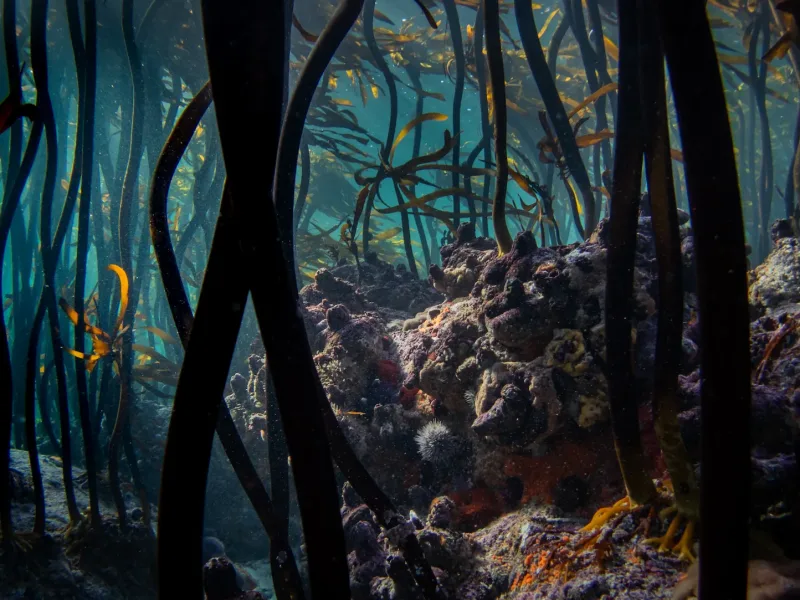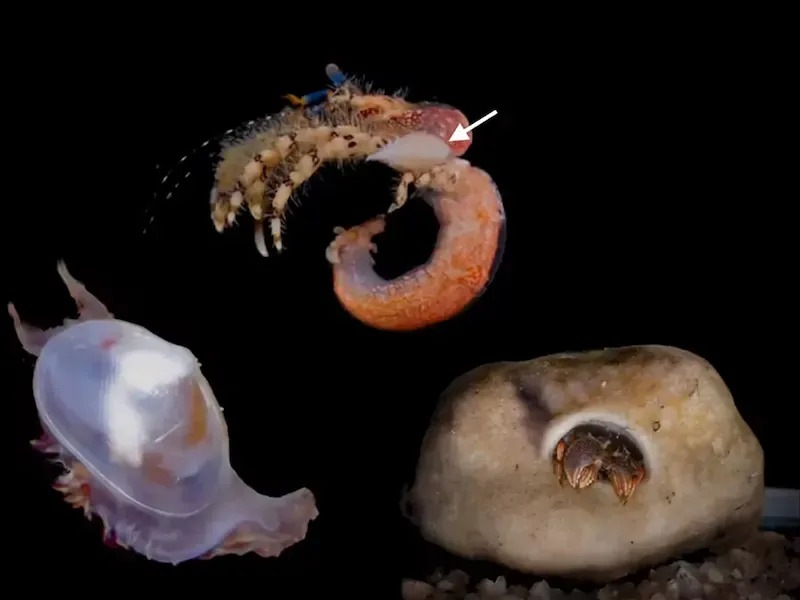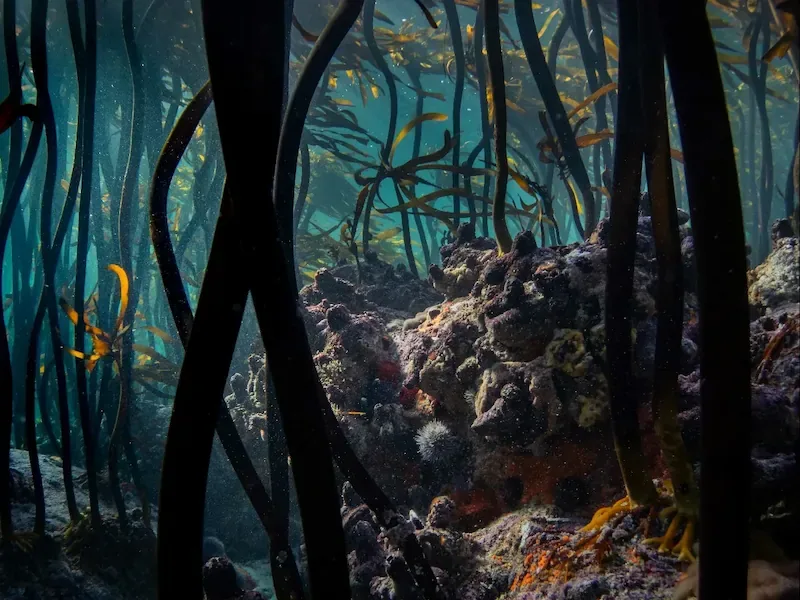1001 Seaforest Species
The 1001 Seaforest Species project brings ashore the stories of 1001 organisms that call the Great African Seaforest home. A scientific inquiry with the art of underwater tracking and storytelling at its heart, core members Dr Jannes Landschoff, Emeritus Professor Charles Griffiths and Craig Foster unveil the secret lives of these creatures. This bid to build a lasting seedbank of species knowledge is driven by an urgent call to inspire awareness of and awe for nature.
Biodiversity – that breathtaking array of life on earth – underpins our survival, and knowing it is crucial for supporting its protection. The number 1001 draws inspiration from the tale One Thousand and One Nights, where a young woman’s endless storytelling keeps her alive night after night, eventually softening the heart of a vengeful king. Similarly, 1001 Seaforest Species seeks to keep Mother Nature alive by sharing her stories, species by species, fostering a profound sense of wonder and an urgency to protect her.
This evolving project is presented simply, with each species arranged numerically starting from #0001: the octopus, the animal that captured the world’s imagination in our Oscar-winning film My Octopus Teacher, to #1001: Homo sapiens, the human in the seaforest. Each animal has a story, and we are all connected in the miraculously complex web of life that is biodiversity.

Octopus
The octopus is our great teacher as she holds a special place in the ecology of the seaforest. We have perhaps got closer, and learnt more from her, than from any other seaforest animal. Nearly every kelp forest species is somehow linked to her behavioural complexity. Octopuses have shown us how they hunt up to 100 different species of prey, how they in turn avoid predation by seals and sharks, and how they master an unimaginable life of camouflage. For us she is the inspiration at the centre of the biological wonder that is Mother Nature.
Background
The oceans around the southern tip of Africa are diverse and unique. The warm, fast-flowing Agulhas Current carries subtropical waters from the Indian Ocean along South Africa’s east coast, contrasting with the cold, nutrient-rich waters of the Benguela Current on the west coast, where giant kelp forests thrive. This contrasting oceanographic diversity makes South Africa’s coastline globally important, with 33% of the >13,000 marine species known thus far being endemic.
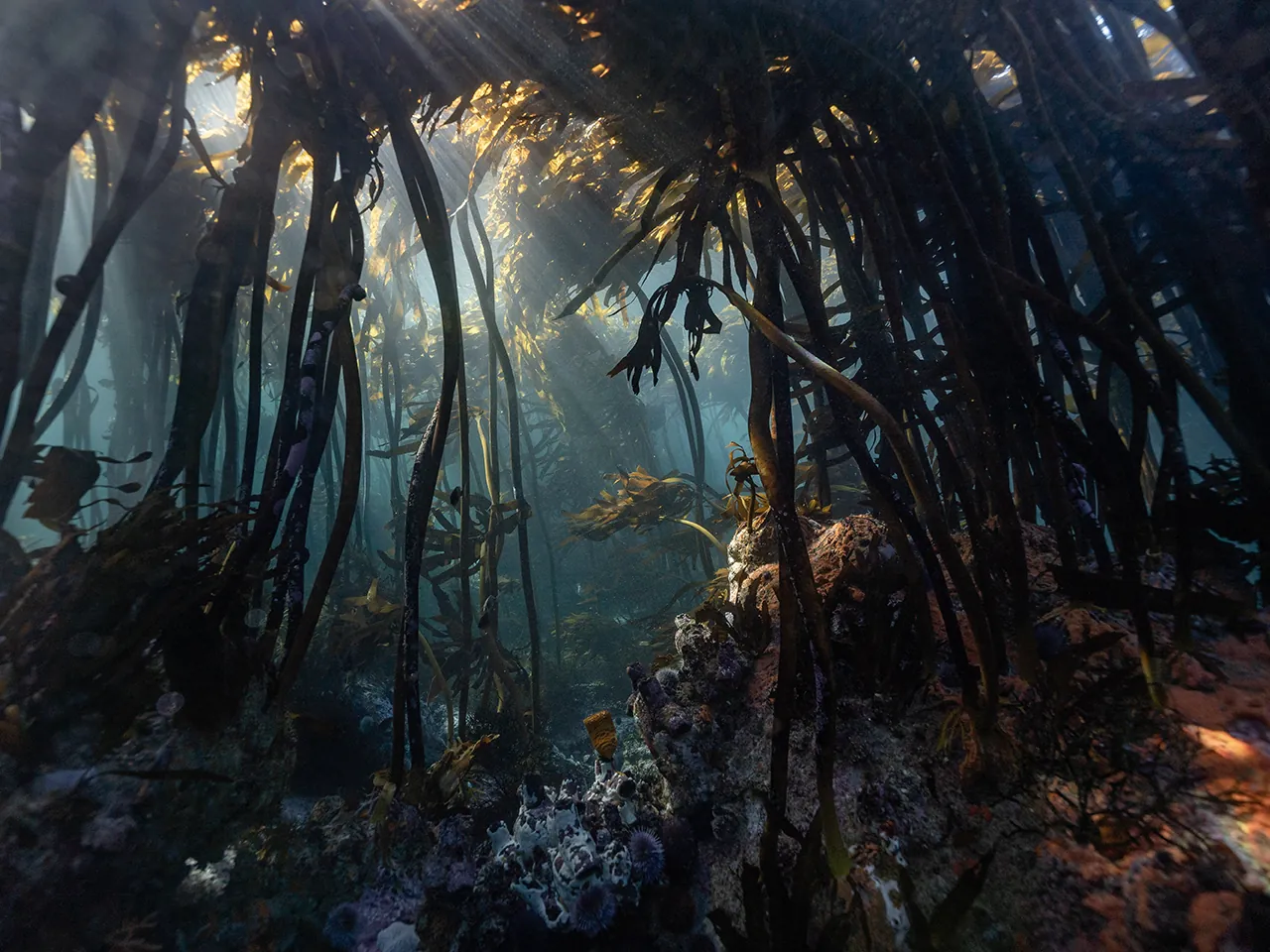


Cape Point near False Bay marks a biological break point for marine species distributions and is home to the Great African Seaforest, a unique and diverse kelp forest ecosystem. Our team has explored and cherished this region for over a decade, helping it gain recognition as a valuable marine ecosystem. We carefully embedded the name ‘Great African Seaforest’ in all our media work, and in 2021 it was named a New World Wonder. This iconic status will help towards its long-term protection.






Aims
As environmental challenges threaten the last remaining wilderness areas of our planet, we use underwater tracking, marine biology research, and storytelling to:
- Foster a holistic understanding of the marine environment
- Connect people to nature, inspiring an emotional bond and care for the natural world
- Raise awareness locally and globally about biodiversity’s essential role in human survival, promoting active participation in protecting the web of life
- Highlight the significance of the Great African Seaforest to safeguard its iconic status and support its preservation
- Bridge gaps between the science-to-policy interface to inspire political action
- Encourage world business leaders to adopt a nature-centred value system
OUR THREE-PRONGED APPROACH
Underwater Tracking
An observational skill honed through presence and connection with the environment, tracking enables a deeper understanding of the seaforest, sometimes even the discovery of new species or novel animal behaviours.
Research
Storytelling
Beacon of Biodiversity
The Great African Seaforest and the ocean at our doorstep represent not just hope, but a living system that enriches our planet at a time when global awareness, policy and enforcement are urgently needed to restore the health of our natural world.
Our 1001 Seaforest Species project is centred around this remarkable kelp forest and the vital marine biodiversity it supports. Through documenting and highlighting the unique characteristics of the species within the Great African Seaforest ecosystem, we emphasise their interdependence and their crucial role in the health of the world’s oceans.
Our strategic objective is to accelerate global awareness of kelp forests in key domains, including the general public, the scientific and conservation communities, governments, multilateral institutions and businesses. We aim to inspire people worldwide to create conditions where such ecosystems can flourish and to energise individuals to take personal action in protecting biodiversity, leading to a deeper sense of purpose and meaning in their lives.

Rock Crab
Rock crabs are key players in the subtidal ecology of South African kelp forest shores, forming healthy populations of omnivorous foragers. While they hunt for small invertebrates, they must stay alert, as they are amongst the favourite food of the octopus. Rock crabs have an impressive escape mechanism: their flattened legs are perfectly adapted for quick swimming when needed.
App
We’re excited to launch the 1001 Seaforest Species app in 2025—a free, custom-built guide to the incredible marine life found in the Great African Seaforest. Designed with an intuitive species identification tool, the app will help users explore a range of categories, from fish to crustaceans and mollusks, and identify individual species with ease. This resource is tailored for the local marine community and anyone fascinated by ocean biodiversity. Highlighting rare and unique species found only in our region, the app will also contribute valuable knowledge to global biodiversity by including new discoveries and first-ever live images of marine life.
Social
#0038 Shaggy sponge crab – Dromidia hirsutissima
Like a holidaying school pupil before the obligatory term-time trim, these small crabs are a shaggy sight, their coiffure made up of long dense fibrous brown, grey or yellow hairs. And, as if that’s not enough coverage, they also often carry a cloak of other ocean dwellers – sponges, ascidians and seaweeds – which protects them (often through added chemical defence) and provides nifty camouflage. One of six species in the endemic genus, five are found in False Bay and the Great African Seaforest. While they are usually nocturnal, Shaggy sponge crabs sometimes venture out during the day, relying on their camouflage to move around undetected.
@saveourseasfoundation #seachangeproject #1001species #1001speciesproject #marinebiology #crab #greatafricanseaforest

#0037 Strap caulerpa – Caulerpa filiformis
They might look like seagrass and sway like seagrass, but these dark-green ‘meadows’ are actually a type of algae. With strap-like fronds that emerge from a smooth white stolon – a creeping horizontal stem – Strap caulerpa grow in the sand with root-like rhizoid anchors that attach to buried rocks in intertidal pools and shallow reefs. They form ecologically important habitat and locally enhance biodiversity, especially of gastropod species. An unusual distinction is that the frond of the Strap caulerpa is one enormous cell containing many nuclei. An easy way to understand this is by imagining a house: usually, it’s divided into lots of little rooms (like cells), each with its own light source. But here, the house is one huge open hall, and instead of one light bulb , there are many lamps around the hall. This species is sometimes confused with seagrass, which is a flowering plant, not an alga. However, like seagrass, it relies on photosynthesis and forms these dense beds that can appear almost luminous in bright sunlight.
@saveourseasfoundation #1001species #1001speciesproject #strapcaulerpa #seachangeproject #marinebiology

#0036 Pink-edge bluebottle – Physalia megalista
Many of us are familiar with blue-hued bluebottles, known for their painful sting. But did you know there are not one but at least two species in the Great African Seaforest, including this pink-tinged one? While its trim colour differentiates it from the familiar blue P. utriculus, other distinguishing features include a strongly crimped sail (the inflated float one sees at the surface) and considerably longer feeding tentacles. Bluebottles are colonial hydrozoans, with each colony male or female. They reproduce by shedding sperm and eggs into the water, forming larvae that drift in the water until a float-forming zooid develops, lifting the colony to the surface. Those formidable tentacles aren’t for malice but for survival: they paralyse small fish and crustaceans, reel them in, and deliver them to feeding zooids for digestion and nutrient sharing across the colony.
#1001project #1001seaforestspecies #1001species @saveourseasfoundation #taxonomy #marinebiology #pinkedgebluebottle #bluebottle

#0035 Ornate amphipod – Cyproidea ornata
Fondly known as the Bumble bee amphipod, these teeny tiny creatures have earned their stripes in warning colouration. Common on shallow reefs, they scuttle boldly in the open, their yellow-and-black bands presumably warning off predators. Bean-shaped bodies, red eyes and striped side plates give them a striking look, despite their tiny size – just 3-4mm, not counting their short antennae. Beloved by macro photographers, they are often tracked as they feed on bryozoans, such as the Rustic lace bryozoan Membranipora rustica, a familiar face from post #0016. Gathered in swarms upon these hosts, Ornate amphipods create a buzz of ‘bumblebees’ riding out mealtime together. 🎬 Swipe to see this in action.
Image and video: @jannes_landschoff
@saveourseasfoundation #1001project #1001seaforestspecies #1001species #greatafricanseaforest #seachangeproject #saveourseasfoundation #marinebiology #amphipods

#0034 Sunburst soft coral – Malacacanthus capensis
When you’re one-of-a-kind, your uniqueness deserves recognition. That’s exactly the case for the Sunburst soft coral, whose tall, cylindrical stalk sets it so far apart from other octocorals that scientists recently placed it in its own family. These rounded balls bearing yellow-to-orange polyps, each with eight pinnate tentacles, are found only in South Africa, from the subtitdal to depths of about 40 metres. The polyps can be retracted into the head when disturbed – and, in another display of special behaviour, a specialised polyp called a siphonozooid acts like a pump, reinflating the colony into the golden fuzzball that delights those who come across it.
@saveourseasfoundation #1001species #1001seaforestspecies #1001speciesproject #greatafricanseaforest #taxonomy #marinescience

Being a marine scientist in the field requires a host of attributes: eagle eyes to spot tiny animals; an excellent memory that can quickly rake through years of accumulated knowledge to identify a species; endless curiosity to piece together seaforest puzzles; patience and persistence – and, in this case, the ability to descend to the seabed with the elegance of a yogi. On a recent dive, Jannes spied a small sea cucumber on a stretch of rippled sand. While most people might have swum past it, thinking it was just another Stephenson’s sea cucumber, Jannes’s science brain knew there was something different about it. Instead of dendritic, tree-like, soft-tipped tentacles for filter-feeding, it had shorter, stubby ends to probably catch other types of prey. After dipping down numerous times to examine it with a torch, he declared it a species he had not seen before, and it would require some digging to figure out the mystery. This quest for answers is just one of the reasons the seaforest keeps calling Jannes back – every dive comes with the possibility of newness and surprise.
#seachangeproject #greatafricanseaforest #taxonomy #marinescience #seacucumber #1001species #1001seaforestspecies

#0033 Cape gannet – Morus capensis
Cape gannets plunge-dive from heights of up to 20 metres – or rocket straight down from the surface – spearing through the water with powerful bills. To cope with the rush of water, they’ve evolved a unique trait: no external nostrils. Instead, these seabirds have a specialised respiratory system that includes air sacs and internal passages – a design that makes perfect sense once you see them in action. These blue-eyed birds dive with precision, power and speed, often in large groups, feeding on shoals of pelagic fish. During the winter months, the famed Sardine Run occurs along South Africa’s east coast, where gannets join dolphins, whales, seals and other predators in a spectacular feeding frenzy. The breeding range of Cape gannets is limited to Southern Africa, with colonies in South Africa and Namibia. While numbers have risen in South Africa, Namibian colonies have declined sharply over the past 50 years, linked to dwindling fish stocks. Could this contrast reflect variants in policy, conservation efforts or ecosystem management? And, if so, what could be done differently?
Images: Jannes Landschoff and @animal_ocean
@saveourseasfoundation #1001species #1001speciesproject #1001 #seachangeproject

#0032 Four-coloured aeolid – Godiva quadricolor
Flamboyant and not averse to overseas travel, Four-coloured aeolids are real charmers, attracting divers and underwater photographers with their flame-like cerata and bold orange-patched head. Unfussy gourmands, these nudibranchs are voracious predators of other heterobranchs and Striped anemones – and even cannibalise their own kind. Baby aeolids emerge from untidy egg ribbons that resemble zigzags of white rice, and settle on sand, reefs, and in kelp and green seaweed beds. Some even travel further afield, turning up as invasive guests in Mediterranean and Australian harbours. From reef to harbour, this flashy traveller shows how marine species can shape – and sometimes disrupt – environments.
@saveourseasfoundation #1001seaforestspecies #1001species #seachangeproject #marinebiology #taxonomy #greatafricanseaforest

#0031 - Janbruin - Gymnocrotaphus curvidens
Bucktoothed and blue-eyed, this seabream is a shy loner, often found sheltering in overhangs and caves. Its eyes are startling – bright turquoise against the coppery-brown colour of its skin, and those protruding teeth come in handy for tearing prey such as tunicates, algae, bryozoans, worms and crustaceans from rocks. A large, plump seabream part of the Sparidae family, Janbruins are diurnal – active during the day and resting at night. Not much is known about the life history and longevity of these handsome fish. Like the reproductive cycle of other members of the family, Janbruin eggs are presumed to develop in the plankton, and they may be one of the seabreams that changes sex as they grow. There’s still a lot to learn about these blue-eyed fish … perhaps with timidity comes more privacy?
@saveourseasfoundation #1001seaforestspecies #1001speciesproject #1001species #greatafricanseaforest #seachangeproject #taxonomy #marinebiology

#0030 - Formidable shore spider - Desis formidabilis
With a name worthy of a Marvel villain, this intertidal spider is actually a survival superhero. Besides its huge fangs, which make up about a third of its body length and enable it to successfully hunt small crustaceans, it has two other unique survival tools. First, its silken nests – constructed by a single female in crevices and under the empty shells of mussels and limpets – are like biological scuba tanks. Air trapped in these nests allows the spider to shelter there during high tide. When the tide recedes, and night falls, they emerge to hunt for their favourite crustaceans – isopods and amphipods. Their second tool involves eggs and a smart decoy. The female spider lays a series of wedge-shaped sacs in the nest – but not all of them contain eggs. It’s thought that the extra sacs act as red herrings to reduce the likelihood of egg parasitism by the Shore spider egg-parasite wasp Echthrodesis lamorali. Air in their nests, air in their sacs – Spiderman would be super-impressed.
@saveourseasfoundation #1001species #1001seaforestspecies #taxonomy #marinescience #biodiversity #formidableshorespider #seachangeproject #saveourseasfoundation

#0029 - Broad chiton (Callochiton dentatus)
Meet the Broad chiton, a dorsally flattened mollusk endemic to South Africa’s intertidal zones. This low-profile grazer is a master of survival, equipped with a powerful muscular foot that anchors it to substrates, and a compact form that reduces drag in turbulent waters. Ranging in size from 20-55mm in total body length, Broad chitons have eight shell plates surrounded by a soft fleshy mantle, and dark spots, or ‘shell eyes’, on the side areas and growth lines. Solitary and herbivorous, these orange- to chestnut-hued animals use a radula – a tongue-like structure lined with rows of teeth – to scrape algae off rocks. First described by Danish naturalist Lorenz Spengler in 1797, the Broad chiton belongs to an organism group that has lived in our oceans for millions of years. Chitons trace back to the earliest lineages of mollusks, yet their design is anything but simple – their teeth are made of magnetite, the hardest material made by a living organism, and their ‘shell eyes’ have a crystalline lens and a pigmented photoreceptive retina.
@saveourseasfoundation #seachangeproject #1001species #1001seaforestspecies #1001project #greatafricanseaforest #taxonomy #marinebiology #chiton

#0028 - Red-spotted ascidian (Ascidia incrassata)
These solitary ascidians are so named because their outer coverings are inflated (‘incrassate’ means swollen, dense, or more substantial). An interesting feature of these outer tests is that they are composed of cellulose, a material normally associated with plants and found only in this group of animals. Cellulose might be a good choice for a protective coating as few animals have enzymes capable of digesting this material! Endemic to South Africa, Red-spotted ascidians – purple to red in colour – have inhalant siphons directed upwards and exhalant ones to the side, with the tips of both siphons folded into eight lobes. These are used to filter feed: seawater is drawn through the inhalant siphon and filtered though a net of mucous, which is continuously generated and passed across the mesh-like walls of the pharynx, before being rolled up into a threadlike cord and transported to the oesophagus. Even the simplest forms can harbour extraordinary complexity!
@saveourseasfoundation #seachangeproject #1001species #1001seaforestspecies #1001speciesproject #marinescience #taxonomy #storytelling #greatafricanseaforest

TEAM
1001 Seaforest Species is a multifaceted project with ambitious goals, made possible through the hard work, support, and collaboration of many valued contributors

Dr Jannes Landschoff
Jannes is a marine biologist, trained crustacean specialist and ecologist who leads the scientific research for 1001. His interests and talents in the field of natural history span from documentary photography and film to ecological biodiversity research and conservation. He is a Research Fellow at the Department of Botany and Zoology, Stellenbosch University.

Craig Foster
Craig has spent more than a decade practising underwater tracking in the Great African Seaforest. He brings these skills to the project by closely observing the ways of the 1001 species, learning from them, and then using his storytelling background to weave rich tales about their often secret lives.

Emer Prof. Charles Griffiths
Emeritus Prof Charles Griffiths is a former Head of the Zoology Department and Director of the Marine Biology Research Institute at University of Cape Town. He has been studying the marine fauna of the region for over 50 years and has described over 100 species new to science. He is author of several guide books to regional fauna and produces a YouTube channel, Explore the Shore ,with his son Matthew. He wrote many of the 1001 Seaforest Species pages.
TRACKING ACKNOWLEDGEMENTS
Craig would like to acknowledge his original tracking mentors — !Nqate Xqamxebe, Karoha Langwane, and Xlhoase Xlhokhne — who inspired his journey into underwater tracking. This technique, shared with Jannes and the Sea Change team, continues to evolve, has led to numerous scientific discoveries and strongly influences the project, for which we are deeply grateful. We also extend our thanks to master tracker JJ Minye for his invaluable contributions to our intertidal and coastal tracking practices.
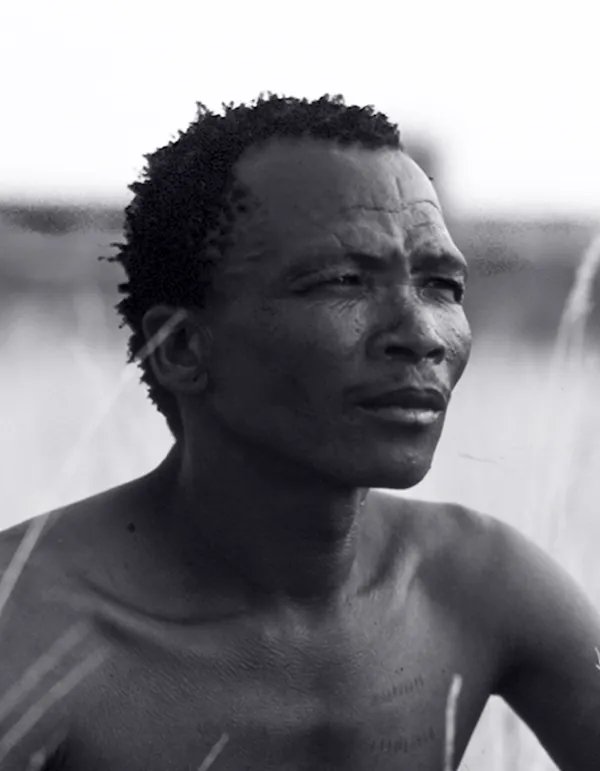
!Nqate Xgamxebe

Karoha Langwane

Xlhoase Xlhokhne

JJ Minye
Principal Partners
Over the years we’ve had the privilege to come to know and work with many of the deeply passionate team from the Save our Seas Foundation (SOSF) – our 1001 Seaforest Species principal collaborator and funder. SOSF have spent over 20 years protecting sharks and rays around the world. We feel very grateful to work with this fabulous team of scientists and storytellers, together giving voice to the countless voiceless animals that are our teachers, our inspiration and our life support system.
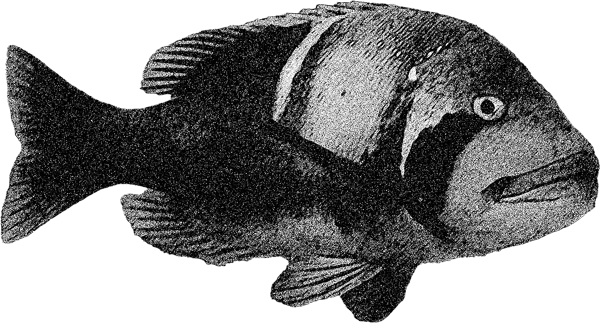
Red Roman
The Red roman is one of the kelp forest’s most iconic fish, known for its curiosity towards divers. These fish start life as females in small groups but, at around 30 cm, transform into males and become territorial over a specific area. In protected environments, they can live for at least 17 years, becoming like kin to those of us who dive there regularly. This large male Red Roman followed us closely on one of our swims, adding to the feeling of being at home in the seaforest.
Media
Recent Articles
New discoveries: three tiny species added to South Africa’s spectacular marine life

